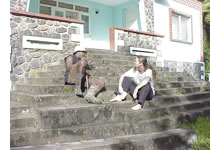

Shortly after the 1999 AIA convention in Dallas, I left my home in the U.S. seeking to learn what characteristics make a "livable community." I was looking for the purest form of a community. Above all, I wanted to live in a community where it was clear that individuals' actions had a real—if not direct—impact on the group as a whole.
I now live in a small agricultural village on a remote island in the West Indies, 200 miles off the coast of Venezuela. Everyone in my village can walk to the market, all the kids can walk to school, and all of our civic institutions (police station, community center, and gas station) are centrally located on the "riverfront"—New Urbanism without the New Urbanists. Yet the cost of living is right at the "national" average, and—with two Peace Corps volunteers here—we're more ethnically diverse than the rest of the country.
 My
best friends here are the guys who work in the banana fields just behind
my house. We spend most of our time together playing dominoes, drinking
rum, and telling stories on my porch. We couldn't possibly be more different;
couldn't possibly have more divergent goals or opportunities in life.
But I have learned from them what I think is the single most-important
aspect of building livable communities: creating shared experiences.
My
best friends here are the guys who work in the banana fields just behind
my house. We spend most of our time together playing dominoes, drinking
rum, and telling stories on my porch. We couldn't possibly be more different;
couldn't possibly have more divergent goals or opportunities in life.
But I have learned from them what I think is the single most-important
aspect of building livable communities: creating shared experiences.
Storytellers and
visionaries
Granted, there's something about living on a 12-mile by 18-mile island
that is a shared experience in itself. But other than that, few of the
religious, social, and cultural activities on the island are truly shared
among all the villagers. I have recently begun to appreciate the incredible
diversity in a place that at first glance doesn't look so diverse. I expected
to find a simple, clear example of a "livable" if struggling
community. I now believe that a community is by definition a diverse place,
and thus building community has never been a simple task.
How does this relate to architects today? Maybe Thomas R. Fisher, dean of the University of Minnesota's architecture school, said it best in his book In the Scheme of Things: Alternative Thinking on the Practice of Architecture (University of Minnesota Press, 2000): "As a profession we are often assailed on the grounds of our not knowing enough about construction, or our not taking enough responsibility for the building team, or our not competing forcefully enough against interlopers. But the question of our professional value rests, I believe, on a more fundamental problem: our having lost our social role as public storytellers and visionaries."
The largest shared
experience
I've often felt that, in the developed world at least, perhaps we were
too diverse, with images too heavy-laden with history and interpretation,
to hope for what I now call "shared experiences." Architects
and urbanists could only create places where shared experiences might
happen-while walking to work, waiting for the subway, sitting in a park-but
we couldn't qualitatively interpret those experiences. I thought that
perhaps this condition was a necessary corollary to living in a larger,
more mobile, and informed modern world. Now I believe I was wrong.
Far from having no role in ensuring shared experiences in diverse communities, I have realized that the built environment is and has always been the single shared experience of communities. Rites of passage always involve individuals or small groups-men rather than women, for example. Cultural celebrations always occur while someone just outside the circle is trying to sleep through the chants and drums. The built environment, whether in a city or a village, provides the only possibility for a truly shared experience.
Inspiration and orientation
As such, we need our communities to tell stories. Real people flock to
the suburbs—even middle-class ethnic minorities—because developers
have embraced what Fisher identifies as architects' roles as public storytellers.
In criticizing the suburbs for promising some impossible utopian ideal,
we architects miss the point. The people living in the suburb of "Coconut
Village" don't really expect or even want to actually live in a village
like the one I live in now-they're using the metaphor like we use metaphors
for our buildings during the design process, as a guiding idea, but not
a literal goal. Ironically, the same is true with my friends and me sitting
on my porch. They're telling stories, not because the stories all actually
happened, but because they need to inspire each other and themselves.
They need to orient themselves, even in the small world of an isolated
island. And architecture is about nothing if not inspiration and orientation.
So while the "shared experience" of many communities remains a fiction-as it does for my little village-that fiction still serves as an important unifying force. Admittedly, the term "livable communities" is itself a fiction. This fiction is also meant to inspire a broad coalition of people with diverse interests to work together towards a common if hopelessly utopian goal. And it's inspiration that our communities need, and which I think architects are capable of providing. The public needs us to be storytellers.
Copyright 2001 The American Institute of Architects. All rights reserved.
![]()
|
Casius Pealer, Assoc. AIA, is a community development volunteer with the U.S. Peace Corps. His current project is an e-commerce Web site to allow people worldwide to buy local crafts directly from the artisans, www.gligli.com. Pealer will be a regular contributor to AIArchitect on livable community issues throughout this year. |
|